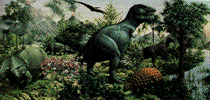The End-Cretaceous (K-T) Extinction

Fast Facts
- Numerous evolutionary radiations occurred during the Cretaceous (144-65 million years ago)
- A major extinction occurred at the end of the period.
- 85% of all species died in the End-Cretaceous (K-T) extinction
Geological Setting
Following the Permian mass extinction, life was abundant but there was a low diversity of species. However, through the Triassic, Jurassic, and Cretaceous, major faunal radiations resulted in a large number of new species and forms. New terrestrial fauna that made their first appearance in the Triassic included the dinosaurs, mammals, pterosaurs (flying reptiles), amphibians (including frogs and turtles). In addition, the first birds appeared in the Jurassic. Among the terrestrial flora, the gymnosperms of the Permian remained dominant until the evolution of the angiosperms (flowering plants) in the Cretaceous. In the Cretaceous there was also major radiations occurring in several esablished grounps including the the marine reptiles, rudist bivalves, ammonoids, belemnoids, and scleractinian corals. Bivalves, and brachiopods. Marine groups that were present but did not undergo major evolutionary expansion in the period included the gastropods,bryozoans, crinoids, sea urchins, and sponges.
Species Affected
During the End-Cretaceous (K-T) extinction (65 million years ago) eighty-five percent of all species disappeared, making it the second largest mass extinction event in geological history. This mass mass extinction, extinction event has generated considerable public interest, primarily because of its role in the demise of the dinosaurs. Although dinosaurs were among the unfortunate victims to perish in the K-T extinction, several other terrestrial and marine biotic groups were also severely affected or eliminated in the crisis. Among those that perished were the pterosaurs, belemnoids, many species of plants (except amongst the ferns and seed-producing plants), ammonoids, marine reptiles,
and rudist bivalves. Organisms which were severly affected included planktic foraminifera, calcareous nannoplankton, diatoms, dinoflagellates, brachiopods, molluscs, echinoids, and fish. Remarkably, most mammals, birds, turtles, crocodiles, lizards, snakes, and amphibians were primarily unaffected by the End-Cretaceous mass extinction.
 Click here to view Causes of the End-Cretaceous Extinction
Click here to view Causes of the End-Cretaceous Extinction
 Click here to view Mass Extinctions of the Phanerozoic Menu
Click here to view Mass Extinctions of the Phanerozoic Menu
 Click here to return to the Main Menu
Click here to return to the Main Menu